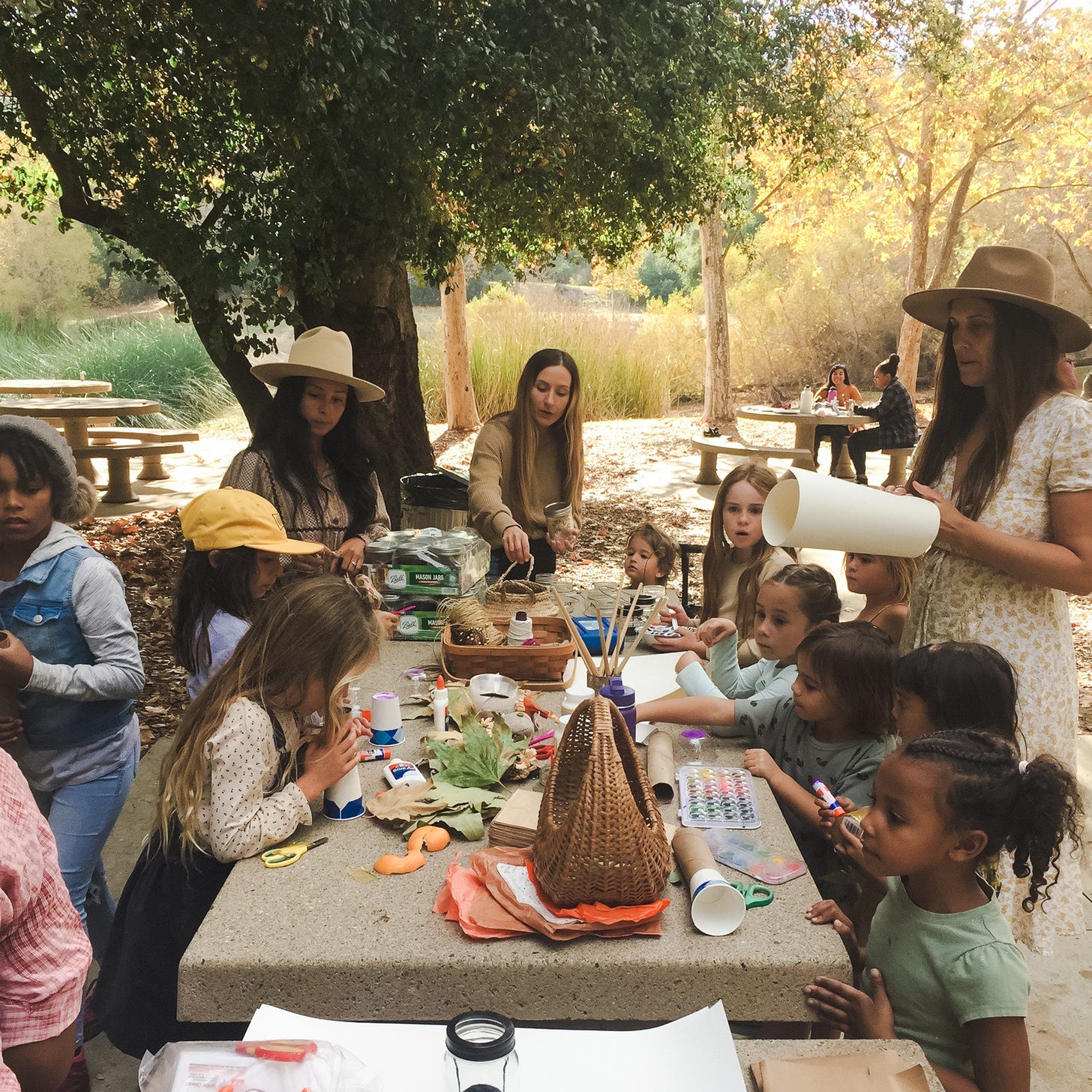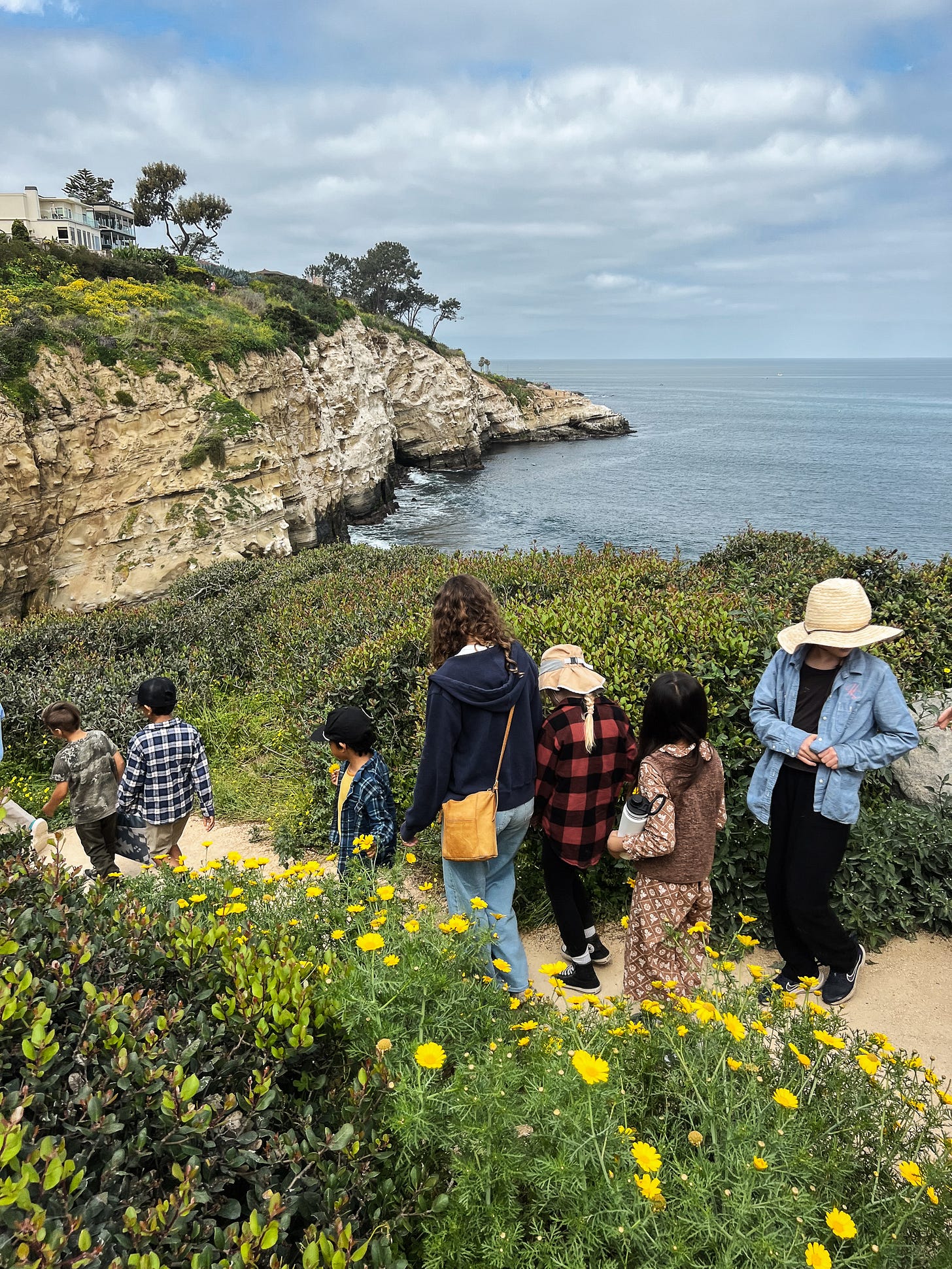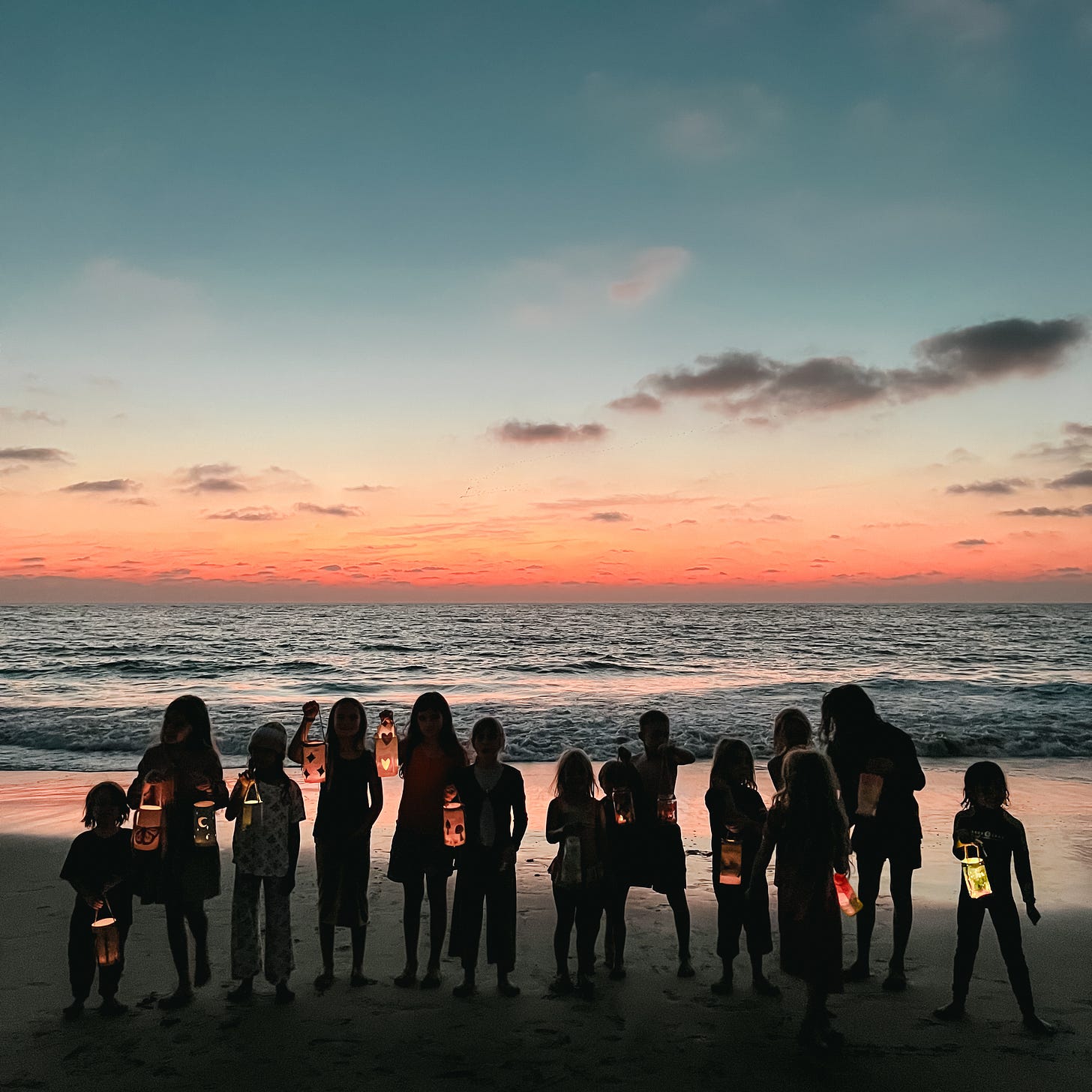The Art of Gathering: An Interview with Elle Celaya
practical and inspiring tips on forming the community you've always wanted
When our eldest, Jude, was only one year old, my husband and I moved 1300 miles south to Texas. Fueled by love, optimism, and a little youthful naivety, I never expected the transition to be so difficult. In college, I made friends easily and found my close-knit community. But as a new mother, it seemed so much harder. I loved my son so much, and I loved being a mom, and yet I felt lonely.
We’re in a different season now with a strong community and close family ties. But I still want to sink even deeper into the value and practice of hospitality. I hope as my children grow, our home will always be a gathering place for friends and family, that it will always feel like coming home in the same comfortable way a special person feels like home.
As a young mom, my friend Elle had a vision of gathering people and she has since created a vibrant, thriving community. I’m so inspired by her. Not only has she offered a place of belonging to so many families, a haven from the loneliness that is so pervasive, but she’s also a wonderful and dear friend to me.
I recently read a report from the Surgeon General that said we are in an epidemic of loneliness and isolation. Half of Americans are experiencing persistent loneliness, and the numbers are even higher in young people. The report's #1 recommendation was to prioritize connection. Elle, this work is so important. We were made for relationships, connection, and community.
What was your original vision in starting a group?
Because I was born and raised in San Diego, I felt called to share what I know about this town with other families. I had a hope for my community that we would all grow in our appreciation of God’s beautiful creation, foster lasting friendships with each other, and see our children grow up together. I started it five years ago, and now I’ve seen these things that I hoped for come to fruition.
My intention originally was to unite homeschoolers because there was not a strong, united homeschooling community at that time. Since then, several different enrichment centers and farm schools have opened, and there are so many more options for community now than there once were. There are so many groups and pods, and our group is full and has been at capacity with 35 families for several years.
This is such an inspiring story because sometimes we might think that if these groups don’t exist in our city, it’s because there isn’t any interest. But really, the interest and ideas are there. They’re just waiting for the right person to come along and execute them.
Yes, there is such a need. Since my group is full, I refer people to open groups all of the time. I think there is always a need. So many people are looking for genuine community. Even people you wouldn’t expect to be looking, like people who are active in churches, are looking, too. They tell me they have spent years praying for community.
Some of us would love to gather others around a shared love or interest, but don’t know where to begin. How do you recommend people get started?
Instagram or Facebook can be a good tool for getting started, but another option is to begin by inviting three friends. You could ask those friends to bring a friend or two. When starting a group, I wouldn’t focus on numbers. Smaller groups can even be better because you want it to be intimate. You want it to have a foundational core of about ten people.
You could create an invitation and send it via text or email, sharing the place and time you will meet, keeping it very easy. You can keep it low-key, for example, you could meet at a park. You don’t have to have a table with food. Everyone could bring a picnic.
A lot of people don’t want to take on the leadership role of starting a new group because they find it daunting. They think it will be a huge time commitment. It’s as much work as you make it, and you can choose to keep it simple.
I love your idea of sending out invitations to open the group. That’s such a special touch, and you are so good with special touches. There is an artfulness to everything that you do, and you make everything so beautiful. How do you balance adding special touches to events, which can make things more magical, while also trying to keep it easy? Is it possible to do both?
I love this question, because I feel like nowadays there is such an emphasis on aesthetics, like making elaborate tablescapes or using neutrals. That can be wonderful and great but at the same time it does add an extra layer of work. My advice would be to keep it so simple.
If there are two things I would recommend to create an environment, it would be a pretty tablecloth and some centerpieces, like Mason jars with sunflowers or a pretty wooden bowl with oranges or tangerines. It’s so simple, but it does it every time. Maybe throw some leaves on the table. It looks beautiful, but it’s easy and people love it.
I recommend bringing back the church potluck concept. That’s what we’ve been doing—we actually call them potlucks—and it has worked out so well.
I think we should place less emphasis on aesthetics and more on deepening the roots of community. We don’t need to seek the visual so much. We can seek the eternal things and the things that are inside of us. That is what makes a group so special.
Do you have any suggestions for a first meeting?
If you're planning to start a nature group, I recommend inviting friends who have children around the same age. Our first meeting was at a park. The scenery was beautiful, and there was lots of grass, and a shallow river that ran through. It was a place where the kids could play and stay occupied as they got to know each other, and of course, you want to choose a place that is safe. While the kids played, the moms had a chance to talk.
For my first group, we met and mingled. We started with 21 moms, and some of us already knew each other or knew friends of friends. Even now, when a new person comes into the group, typically a few of the people already know her because we live in the same town. More often than not, people find that they have connections, and connections seem to happen so naturally. Things naturally orchestrate themselves.
I often hear people talk about finding a “like-minded community.” But ultimately, we will all have some shared values and some differences. How do you bring people together in such a divided world?
One way my original vision has shifted is I realized it is important to have a list of agreements for the group. We have people from different backgrounds and belief systems. I added a clause that we would only discuss things that unite us. It is a major agreement in the group that we aren’t going to talk about politics or religion unless it is motivated by a spirit of unity, acceptance and respect.
I want my group to feel more like a close family. These are the families I want to do life with. I want my children to learn from their children, and I want teenagers to be influenced by one another. Now layers of friendship are being created, from toddlers to teenagers to parents.
My dream of seeing us grow together and raise our children together is happening. The closer we have become, the more I protect the sanctity of our group. That feels very important to me. If new people are invited in, it can’t be at the expense of the health of the group.
So you created a list of agreements for the health of the group. What other agreements do you include in the list?
I think a list of agreements is key in sharing your own vision for the group, almost like a mission statement. For our group, we have created a culture of openness.
If you’d like to read our list of agreements, you can find them below.
How often do you recommend that groups meet in order to create a good rhythm? Do you have meeting attendance requirements?
We meet every Friday, and we require people to commit to meeting twice a month. We think it’s an important agreement because our group wants to foster deeper relationships. If people only choose to come to the big events or to the best field trips, they’re experiencing the highlights but not necessarily a more intimate level of community. Relationships tend to remain more on a surface level, and people would miss out on the fullness that a deeper community offers.
In addition to your weekly nature group, you also host mom nights. Can you tell us more about that?
I was thinking through why my group has been so successful, I mean, we do life together. We have become a family. I think this is because our moms genuinely love each other and we desire to be together. And that was fostered through moms’ nights and the different seasonal things that we do, like our winter party, a girls’ Valentine’s night, a midsummer evening, and through planning events together. It keeps us connected, and people share what’s going on in their lives. It creates such a good atmosphere. You can feel it when you come into the room. The mothers want to be there and they work to make it happen. Four of my friends live over an hour away, and even when it’s hard, they come because they want to be together. We’ve gotten to see the different parts of each other without kids and that is very special. The way moms act and interact when their kids aren’t around is like a totally different world.
I think the seasonal element is important. Even in San Diego, where we don’t really have seasons, we still celebrate them. It’s helpful to have a leader who is a noticer and can pull from nature. When you align with what God is already doing in the world, you can notice and pull from that. You create traditions that only build over time. We are rhythmic people. People like routine, and, especially in community, we thrive in cycles, just like the seasons.
Another tradition is our Friendsgiving with all of the kids and families. We keep it simple. We do it potluck style. I create a menu. I use the app GroupMe and put it on a thread. I recommend GroupMe because you can create your own calendar, events, and threads and sub-threads. You can plan on these threads. People sign up for different dishes or desserts and it’s easy.
You touched on a great point that gathering and connecting isn’t always easy. It’s not like the universe perfectly aligns every time, and it’s only a joy getting there. It’s helpful to know it takes effort, commitment, and dedication and that it’s worth it.
Yes, there is definitely an art to it and like any form of art you have to practice. It takes commitment and time. You might start off and mess up or feel awkward as far as new relationships are concerned. It’s a muscle in us and if you haven’t activated or strengthened that muscle, it takes time.
Once the group is formed, if new people come in, it can take time for them to feel comfortable. So with new people especially, I try to give them more of my time. I introduce them. I introduce their kids to the other kids in the group. Sometimes I will rearrange people at a table, so the teenagers are together and everyone feels included. Little acts like that go a long way.
Especially being a leader you have to cultivate relationships. It’s something that I have learned. It wasn’t natural for me. I actually wasn’t very good at it when I first started the group. Sometimes I would find myself in a deep conversation with one person. I recognized how as a leader, it helps if I make sure to talk with everyone, to be sure everyone feels included. It’s an art and a gift that you can learn.
How do you share the work of leadership so everything isn’t all dependent on you?
This is a really important question. For the first two years, I took on the leadership role by myself. After that, two of my friends offered to help. That can be hard for some people, because you have to open up yourself and the group that you created to other people, to other ideas, to their minds, and be ok with things being a little different. Sometimes it’s maybe not exactly how you would do things.
We take turns with monthly planning. One of our leaders stepped in the last two months of this past school year when I felt on the edge of burnout and she planned several amazing field trips, like strawberry picking and a marine biology trip. Her help came just in time and made me feel rejuvenated and excited to finish the year strong. It’s very important to choose the right friends to team up with. You have to be flexible, and you have to have leaders that you really trust. It helps to form agreements within the leadership.
What is making you come alive outside of leading your group right now?
Gosh, so many things right now, Rachel, I really can’t say just one. All the things are under the umbrella of: I feel like I am entering a new season of motherhood, a new season of being a woman in her 40s. It’s almost like an awakening, like I’m emerging out of a chrysalis. I’m entering into who I used to be before I had children, but through the experience of motherhood, I’m a new person also. So I’m going to the gym, and reading with a friend, and talking to you and I’m being inspired by deep things. Reading C.S. Lewis has inspired me in a crazy way and The Medieval Mind of C.S. Lewis by Jason Baxter has changed my paradigm of how I think about history and how I view the world. I’m awakening into a new season of motherhood, where I have more time for myself to be in tune with God’s voice.
When I was younger, I had no idea that I’d be doing the things I am doing now in my 40s. I feel strong and vibrant and capable, like I have so much ahead of me. The season with little children was beautiful and all-encompassing, and you learn so much through all your sacrifices and through the fire of motherhood. Being a parent is so refining and it brings us so much closer to God. But on the other side of that purge, that sanctification, we become a different being. Your brain is different, the way you think about life and what you appreciate is so different. It’s like an enlightenment. I feel like I’m learning more, that my brain can take in more, even than when I was back in my college days. I feel so inspired, so open, so interested. And then the self-discipline that arises out of the early years of motherhood strengthens you so much. All of the sudden, I realize that I can wake up early and I can be the kind of example I want to be for my kids. I want to create habits that I’d want my kids to have when they are older, showing my kids that life after being a parent of little kids is beautiful and fun. I love when my kids say, “You like being a mom!” And it makes me want to cry because they genuinely know that I love it. There is something so special about that, and the example we can be. Just that alone makes me feel alive.
Other Interviews in the Series:
The Art of Commonplacing: An Interview with Leah Boden
Establishing a Home Life Rhythm: An Interview with Jennifer Pepito
An Interview with Flower Farmer Sarah Davis
An Interview with Pattern Designer Rae Hoekstra
An Interview with Photographer Naomi Ovando










Thank you so much Rachel!! This was SUCH a fun experience!! You asked very important questions and made me really have to think about the different layers of community. Love you and everything you create so much!!
Great interview! Thank you for sharing 💖Lots of great tips and inspiration on such an important topic. I love when you both touch on how it isn’t always easy and that it takes commitment and time but that it’s worth it! When I was younger I suffered from what I called “sitcom syndrome” where I thought friendship looked like it does in sitcoms. Friends, New Girl, that sort of thing. And it made me miss the eclectic friendship opportunities that were right in front of my nose. I think the same can be true with homeschool moms and community - we see something online that we wish we had but it’s best to get busy building community with the connections or possibility of connections we already have! Also that it takes time… Sometimes it is hard to be patient. I’m early on in my motherhood and homeschool journey so it’s very encouraging to hear wisdom from more experienced mothers like you and Elle! Thank you! Xo